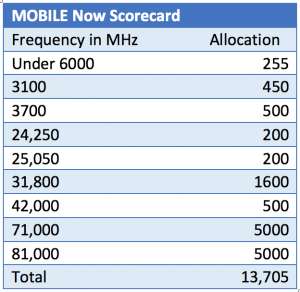MOBILE Now: All the Spectrum We’ll Ever Need?
Mobile networks will be in good shape for spectrum for the foreseeable future if Senators John Thune (R, S. Dakota) and Bill Nelson (D, Florida) pass their MOBILE Now Act in anything close to its present draft form. The overall quantity of spectrum the bill seeks to make available to mobile networks in all modes – licensed, unlicensed, and shared between government and the public – adds up to 13.7 GHz. To put that in context, today’s spectrum assignments for cellular licenses, Wi-Fi, microwave, and millimeter wave probably add up to less than 3 GHz at the far side, and with close to half assigned to Wi-Fi when the 5 GHz allocation is complete.
The MOBILE Now Scorecard
Here’s a simple tally of the new spectrum this bill seeks to make available.
What the MOBILE Now Spectrum is Good For
Now let’s examine what this spectrum is good for and what has to happen to make it available and to use it.
The 5G mobile broadband systems scheduled to be fully specified by 2020 (with test networks appearing in a matter of months) push the boundaries of radio technology in three major ways:
- Creating means for several narrow bands to be treated as a single wider band;
- Focusing radio beams and coding bit streams to minimize interference in both the analog and digital domains;
- Extending mobile broadband into the ultra-high frequency bands known as “millimeter wave”, at 25 GHz and above.
The first two advances are incremental improvements over existing systems, so there’s not much doubt they’ll pay off. For some years now, wireless broadband systems have used feedback loops between senders and receivers for senders to self-assess the quality of the paths they’re using and make adaptations to optimize throughput. Digital radio systems always feature tradeoffs between efficiency in bits/second and Hertz, and signal assessment allows these tradeoffs to be optimized. Similar adjustments to waveforms focus beams at the target system and minimize pollution of nearby systems.
Similarly, MIMO has been in use since IEEE 802.11n, and has now advanced from simple 1×2 and 2×4 antenna arrays (more is better) to 8×8 and even 64×64. And basic and massive single user MIMO has given way to Multi-User MIMO and Massive Multi-User MIMO.
The other technologies that reduce interference are SDMA and beam forming; they use channel assessment along with the ability to adjust radio beams in terms of energy in sectors of space to steer the beams toward their desired targets much as skeet shooters track targets in the sky before pulling the triggers on their shotguns.
The point is that little new technology has to created from scratch for 5G to work, we simply have to make the ones we already understand work better, faster, and cheaper, which is what Moore’s Law is all about. As we advance into higher frequencies some interference problems get harder and some get easier. Foliage can block millimeter wave signals, but millimeter wave signals don’t spread. Hence, the ability to steer beams becomes ever more important, as does the ability to extract information from reflected beams, which we’ve had in various forms since people like John Cioffi developed robust way of impressing bits in radio frequencies.
How We Can Use the MOBILE Now Spectrum
In terms of applications, the MOBILE Now spectrum will unlock faster mobile broadband, additional fixed wireless channels to homes, offices, and schools, and the Internet of Things. The value of all these new modes of communication and new applications is high, of course.
Wires are an inconvenience that we’d rather do without in nearly every case. Not only are they expensive to install, they’re often safety hazards as well as targets for malicious actors. Fiber optic cables have massive capacity, which raises the value of cable cuts to terrorists. Cutting a radio beam, even a wide one, in a inventory of dozens of gigahertz has very little effect, however.
MOBILE Now will do wonders for rural broadband and for the precision agriculture systems used by modern farmers. While city folks like to sneer at their rural cousins, the self-driving cars we like to dream about use systems that were pioneered ten years ago for self-driving tractors. So farmers are the ones who should be doing the sneering, if anyone can.
What Has to Happen to Put This New Spectrum to Use
This is the hard part. Most of the spectrum below 6 GHz is going to come from government agency allocations that are currently in excess of demand, or which would be if agency systems were up to date. So the major hurdles to overcome in the lower bands are administrative. See Section 10, Reallocation Incentives, for a discussion of ways to motivate agencies to reduce their spectrum footprints. I suspect the answer to this dilemma – agencies using spectrum inefficiently because they lack means to upgrade systems – will com from the sale of licenses or from equipment for spectrum swaps.
Just as relocation of current uses is a policy problem, so too are the barriers to faster wireless broadband that come from the demands that high speed data upgrades place in current systems of access to infrastructures such as poles, conduits, and rights of way. So the bill extensively covers a range of streamlining to speed up permitting, finally enact “Dig Once” provisions in highway bills, and simplify contracts with federal agencies for access to infrastructure in multiple locations.
Congress can only do so much in this area because it doesn’t have jurisdiction over lands owned by states and private parties. So a fully functional MOBILE Now will need to address issues at the state and municipal levels as well. The option of using high band radios to replace long haul cables is also an option, but high bands and long distances aren’t a great combination.
One thing that should be made clear is this: Using millimeter waves will only achieve high throughput if we can install many times more radio sites than we have today. The authors get this, hence they’ve included language that addresses small cell and shared antenna scenarios in Section 6, “Distributed Antenna Systems and Small Cell Infrastructure,” even though it’s simply a pointer to an open FCC proceeding. The hint here is that the FCC needs to begin to focus more on our broadband future than on some of its other preoccupations.
Finally, the technology to use most of the MOBILE Now spectrum – the parts above 70 GHz – doesn’t really exist today. So when we say the bill allocates 13.7 GHz of new spectrum, there’s a caveat attached to 10 Ghz of that total. It’s reasonably clear that this spectrum can be used someday, but handheld mobile devices will need to address power problems before they can be among the beneficiaries. It’s going to be great for precision agriculture much sooner, which benefits those of us who enjoy eating.
Conclusion
The MOBILE Now Act by Senators Thune and Nelson allocates 13.7 GHz of new spectrum to mobile systems and addresses utilization barriers. As it’s an act of Congress rather than of God, it can’t address all of the barriers that exist outside the federal scope. While it lists all the implementation barriers of federal significance, it’s light on the details that concern federal agency systems and securing agency cooperation.
But the mere fact that a bill like this is necessary speaks volumes about the ineffectiveness of America’s present spectrum allocation regime. With responsibilities split between the FCC and NTIA and NTIA lacking the power to force agencies to upgrade their systems, Congress become the de facto spectrum manager for the nation. While this bill sets high goals and moves the nation in the right direction, there’s much to be done on the policy front to make measures such as this one agency matters rather than Congressional actions. Once the dust has settled from the current year’s political business, I hope we can get to a more durable solution.





